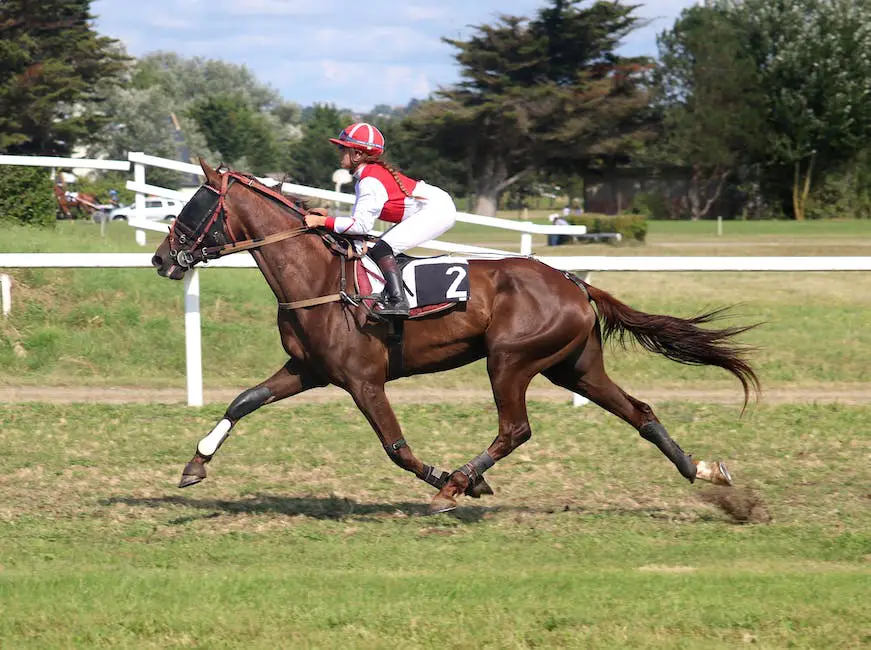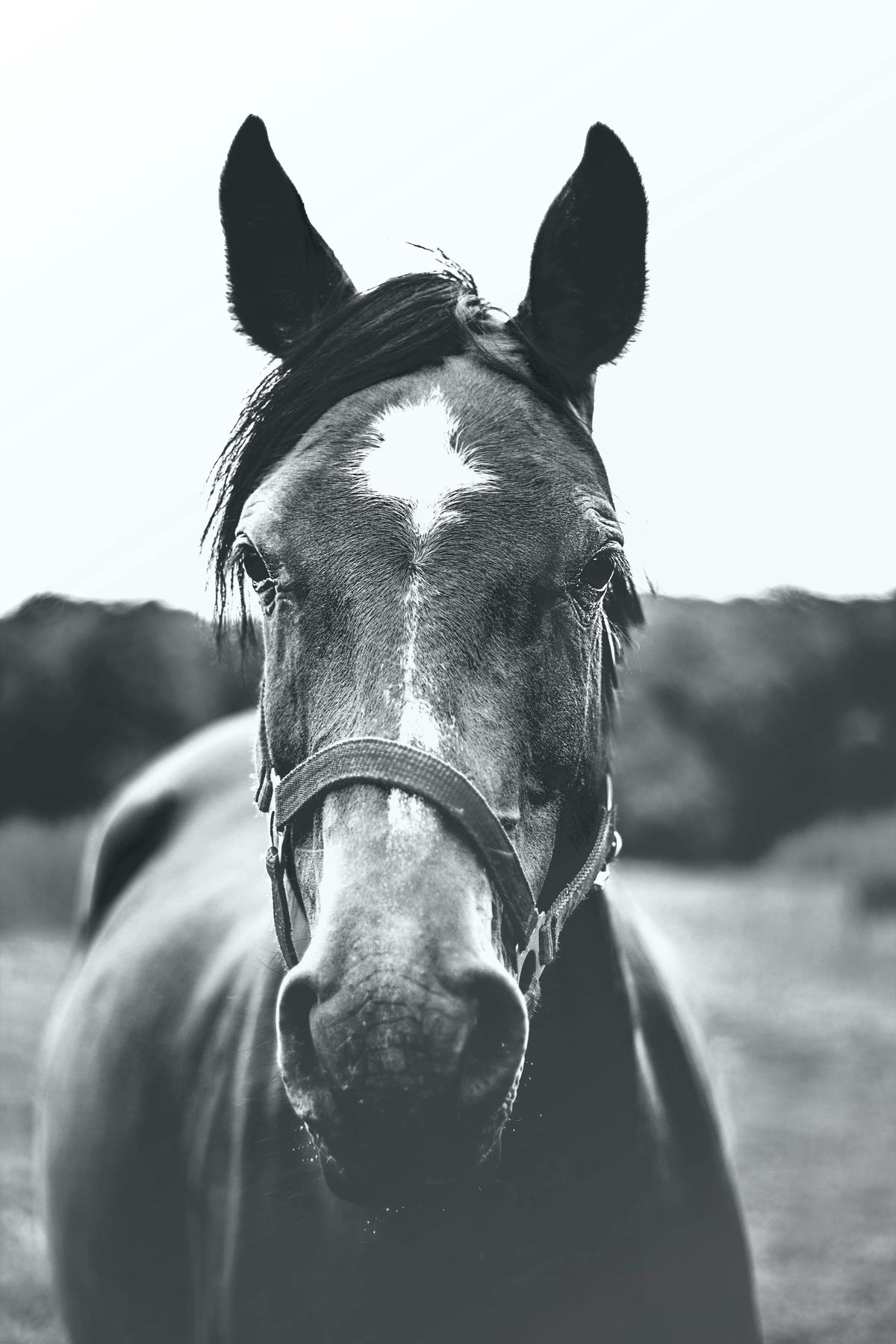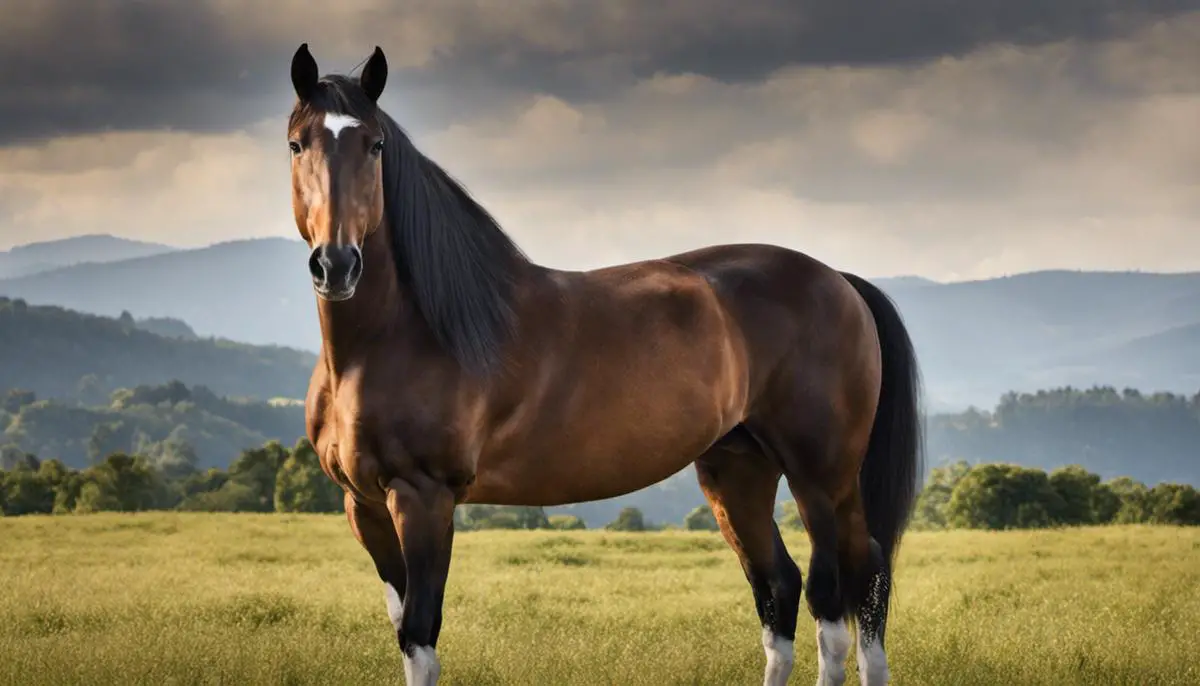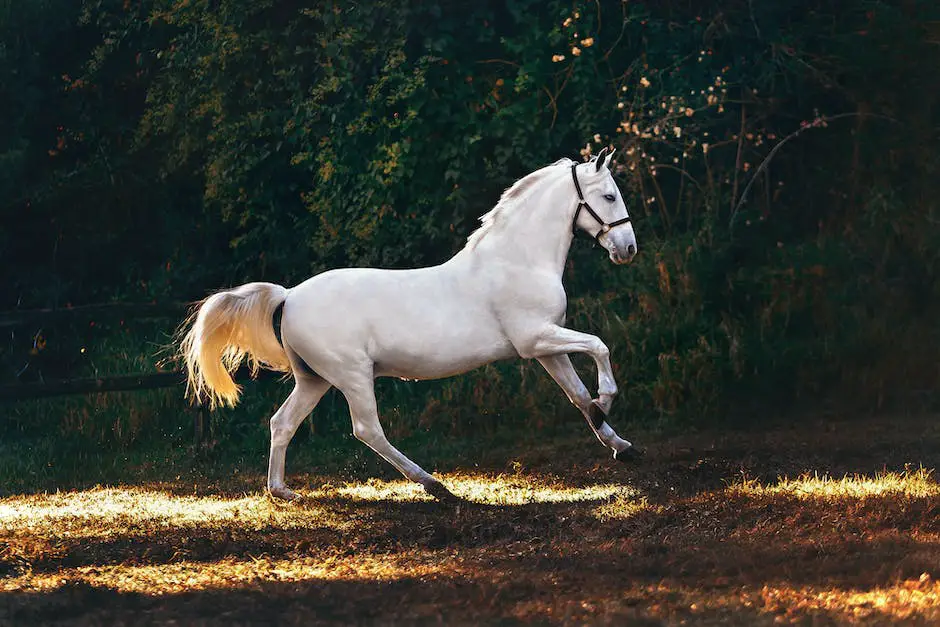Oscillating through the annals of time, the majestic Oldenburg Horse’s story traces its roots back to the 17th century. With origins etched in nobility, the horse breed has a historical significance that echoes through Germany’s verdant landscape. The mastermind behind their development, Count Johann XVI, recognized the breed’s potential, setting the stage for its evolution through meticulous crossbreeding. The modern Oldenburg Horse, with its striking physical traits, asserts its presence with poise and power, diverse skills, and a dynamic temperament. Caring for these horses demands a comprehensive understanding of their diet, exercise patterns, grooming, and healthcare routines. This exploration into the Oldenburg Horse’s world provides insights not just into its legacy and characteristics but also the joys and commitments of owning and nurturing this breed.
Table of Contents (Horspedia)
Origins and History of the Oldenburg Horse
Origins of the Oldenburg Horse
The Oldenburg horse, celebrated across the globe for its impressive size and stylish carriage, traces its roots back to the 17th century in the Northwest region of Germany, known as the Grand Duchy of Oldenburg. This breed is heavily intertwined with the area’s history, having been shaped and refined over centuries by the ruling counts and dukes of this region.
The development of the Oldenburg breed was largely driven by Count Johann XVI. The Count was so dedicated to improving the breed that he ensured only stallions of outstanding quality were allowed to service local mares. Through his efforts to selectively breed horses, a powerful and attractive horse with a good temperament, known today as the Oldenburg horse, was produced.
Crossbreeding and Evolution
The Oldenburg horse’s evolution is a testament to the success of careful, strategic crossbreeding. The breed’s excellent characteristics are derived from several other breeds, with the early Oldenburg horses influenced by Friesian and Spanish lineage. Count Johann XVI began using Neapolitan, Turkish, and Andalusian stallions to refine the breed further, and later on, Thoroughbred and Hanoverian blood was introduced to ensure even better movement and versatility.
This conscious infusion of diverse bloodlines led to several physical improvements in the breed over time, transforming the Oldenburg into a horse that was larger, stronger, and more versatile. From being powerful war horses and important for agricultural work, Oldenburg horses developed into show horses and carriage horses due to their elegance, strong bodies, and energetic gaits.
Significance in Germany
Within Germany, the Oldenburg horse holds a rich and significant history. It was one of the first horse breeds to undergo strict selection and breeding regulations, contributing to its high status and recognition in the horse breeding world. The Oldenburg studbook, established in 1861, is one of the oldest warmblood studbooks around.
Oldenburg, the region of the breed’s origin, remains a significant center for horse breeding and equestrian activities to this day. The Oldenburg horse continues to excel, not just in local shows and competitions, but also on the international stage, asserting their reputation as high-performance dressage and jumping horses. They are appreciated for their intelligence, willingness to work, and extraordinary athleticism.
The Oldenburg ranks among the modern sport horses of today
Regarded highly by top competitors in dressage, show jumping, and eventing, the Oldenburg breed is a prominent testament to Germany’s equine-focused heritage. The breed’s transition from a hefty, all-purpose horse to a contemporary sport horse is an excellent illustration of the impactful changes brought about by careful and selective breeding programs.

Physical Characteristics and Abilities
A Closer Look at the Oldenburg Horse’s Physical Characteristics
Originating from the grand duchy of Oldenburg in northwestern Germany, the Oldenburg Horse is a distinctive warmblood breed. Recognized for its commanding size, Oldenburg horses typically measure between 16.2 and 17.2 hands in height, translating to approximately 66 to 70 inches from the ground to the withers, the highest point on a horse’s back.
Despite their imposing size, Oldenburg horses are celebrated for their grace and elegance. They flaunt a straight or slightly convex profile, a long, well-set neck, and a robust, full chest. Their bodies are compact and muscular featuring a short, sturdy back, a deep girth, and a wide, well-filled chest. Their legs are sturdy and well-structured with distinct joints and solid hooves.
When it comes to color, these horses display a variety of solid hues. Typical colors are black, brown, bay, gray, and chestnut. However, less common colors like palomino and buckskin can also be seen in the Oldenburg breed. They often sport white markings, which may manifest as stars, strips, socks, or blazes.
Understanding the Oldenburg Horse: Abilities and Uses
One of the defining traits of the Oldenburg horse is its powerful and fluid movements. They possess a bold trot characterized by long, sweeping strides and significant “hang time,” lending an effortless grace to their motion. This makes them highly suitable for dressage where smooth, fluid movements and a commanding presence are essential.
Beyond dressage, Oldenburg horses are valued for their show jumping skills. Their robust build, coupled with a natural agility, makes them standout performers in the ring. They deliver jumps marked by accuracy, power, and agility, securing a competitive edge in this discipline.
However, their use doesn’t stop at show jumping and dressage. Oldenburg horses are often employed for carriage driving, exhibiting their strength and stamina by hauling heavy loads over vast distances. Their even-temperament instills reliability and safety, making for smooth and stress-free carriage rides.
These horses offer a versatility that is not confined solely to the equestrian arena. Their physical prowess and endurance equip them well for farm work, whereas their intelligence and eagerness to work render them an invaluable aid in agriculture.
To sum up, the Oldenburg Horse is a well-rounded breed, noted for its splendid physique, impressive gaits, and a wide range of equestrian skills. Their physical attributes and natural aptitudes, along with their adaptable nature, make them suited for a range of equine environments, from dressage circuits to the farmyard.

Photo by josephineamaliepaysen on Unsplash
Temperament and Suitability
The Temperamental Traits of the Oldenburg Horse
The Oldenburg Horse is notable for its outstanding temperament. Recognized for their pleasant nature, these horses exhibit an affable demeanor, which promotes a respectful understanding between the horse and the handler. Their intelligent and discerning nature often reflects in their learning ability, making training more effective and stress-free. This intuitive breed often responds even before a command is given, fostering a harmonious riding experience.
What sets Oldenburg horses apart is their eagerness to please. This breed is known for its cooperativeness and trainability stemming from a genuine desire to satisfy their handlers. Their patience and readiness to take on work make them ideal for a variety of tasks and roles such as dressage, show-jumping, and pleasure riding. Their amicable nature forms the foundation for a rewarding bond between the horse and rider.
In addition to their intelligence, Oldenburg horses stand out for their stamina and dauntlessness. They embody an adventurous spirit and are not easily intimidated, displaying their courage in competitive settings as well as casual riding.
Suitability for Various Levels of Riders
The Oldenburg horse breed is not just favored by professional riders for sport, but it’s also suitable for amateur and less experienced riders due to its calm and easygoing nature. It’s composed, intelligent, and patient, traits that make it ideal for beginners who are still learning the ropes. Their resilience and hardy constitution also make them suitable for older riders.
The breed’s ability to understand and respond to commands quickly makes them an excellent choice for riders at all levels including those participating in top-tier equestrian sports. Their agile movement, strength, and agile coordination are appreciated by athletes and pleasure riders alike.
Adaptable to Different Settings
In terms of adaptability, Oldenburg horses stand out. They are resilient and flexible, comfortable in various environments – from busy equestrian sports arenas to serene countryside fields for leisurely riding. This versatility makes them a champion breed in global equestrian spaces.
They are also adaptable in terms of the activities they take part in. They excel in dressage, show-jumping, and eventing, but are also equally apt and comfortable in carriage driving or pleasure riding. Their well-built, muscular bodies are designed for power and endurance, while their intelligence and disposition make them receptive to various kinds of tasks and disciplines.
Final Thoughts
When it comes to finding the right companion for either sports or pleasure riding, the Oldenburg horse stands out for its remarkable adaptability, pleasant disposition, and intelligent nature. The versatility of this breed allows it to accommodate various levels of rider expertise and an array of environments, truly affirming it as a priceless breed for horse enthusiasts across the globe.

Care and Maintenance of Oldenburg Horses
Nourishment for Oldenburg Horses
Like all horse breeds, Oldenburg horses require a well-balanced diet to ensure their optimal growth and health. This diet primarily comprises hay, grain, grass, as well as fruits and vegetables. High-grade hay is an essential source of nutrients and fiber necessary for their digestive health. Grains such as oats, corn, and barley provide the critical energy these active horses require. That being said, portion control is important when it comes to grains, to prevent health disorders like colic and laminitis. In addition to their primary food, fresh fruits and vegetables can be offered as treats or as a supplement to their regular diet to enhance their vitamin and mineral consumption.
Exercise and Training Needs
Exercise plays a vital role in the proper development and maintenance of Oldenburg Horses’ health and well-being. Regular workouts control weight, improve stamina, and keep the horse in a good mental state. The breed is known for its athleticism and versatility, with many excelling in disciplines such as dressage, show jumping, and eventing. Therefore regular training in these areas is beneficial and suits their energetic nature. However, make sure the exercise is age-appropriate to prevent injuries and fatigue.
Grooming Essentials
The Oldenburg horse has a beautiful coat that requires regular grooming to keep it shiny and healthy. Regular brushing removes dust, dirt, and sweat from the horse’s skin and allows early detection of any skin diseases or parasites. Besides brushing, routine care should include hoof picking to remove rocks or debris which could cause discomfort or injury, regular mane and tail combing to prevent tangles, and thorough cleaning of the eyes, ears, and nostrils to ensure they are free from any signs of infection.
Healthcare and Vaccination
A routine healthcare regime is a must for the Oldenburg horse. Regular veterinary checkups can help identify potential health problems early and keep your horse in optimal condition. Parasite control is essential, and deworming should be done every two to three months. Additionally, annual vaccinations against common equine diseases such as Equine Influenza, Tetanus, and Equine Herpesvirus should be administered. Dental care is equally critical; annual teeth floating can prevent eating difficulties and discomfort.
Managing Common Health Issues
Though unlike some breeds, the Oldenburg horse doesn’t have a high predisposition to specific genetic diseases, they can still suffer from common equine health issues. These include colic, lameness, and respiratory diseases. Feeding a balanced diet, proper exercise, and regular vet checks can help prevent these, but it’s essential to keep an eye out for early signs. For instance, sudden changes in behavior, limping, or a decreased appetite are all red flags that call for immediate veterinary consultation.
Maintaining the Health and Happiness of Oldenburg Horses
Ensuring the optimal health and wellbeing of an Oldenburg horse begins with providing them a clean, secure environment. These horses require ample space for movement and exercise, as well as ready access to fresh and clean water multiple times a day. Shelter from harsh weather conditions is also crucial. As social creatures, Oldenburg horses need frequent interactions with either their fellow horses or human handlers for their emotional wellbeing. Thus, spending quality time with your Oldenburg is an essential part of their care.

Buying and Ownership considerations
The Financial Implications of Purchasing and Caring for an Oldenburg Horse
Given their athletic nature, Oldenburg horses typically bear a higher price tag than average horse breeds. Currently, an Oldenburg horse may cost between $5,000 and upwards of $1 million. This price is dependent on factors like pedigree, age, training level, and unique abilities. However, buying an Oldenburg is only the first financial hurdle. Taking proper care of them involves continuing expenses in areas such as shelter, food, veterinary care, and training. Thus, before investing in an Oldenburg horse, it’s imperative to consider the long-term financial commitment.
Commitments Involved in Owning an Oldenburg Horse
After financial aspects, comes the commitment towards caring for your Oldenburg horse. They require regular exercise to keep their muscles toned and prevent them from getting overweight. They also need routine health check-ups due to their susceptibility to common horse diseases and their athletic nature. Social interaction is necessary for their well-being, which means regular engagement for enjoyment and stimulation. Time investment is a significant aspect of owning an Oldenburg horse.
Finding the Right Oldenburg Horse
The Oldenburg Verband or the Oldenburg Horse Breeder’s Society is the best place to start if you’re looking for an Oldenburg horse to buy. The organization holds regular auctions that can be attended in person or virtually. Breeders specializing in Oldenburg horses can also provide a wealth of options. Remember to conduct due diligence by studying the horse’s lineage, temperament and performance history before making a purchase.
Confirming the Breed
Identification of a purebred Oldenburg involves studying the horse’s lineage, known as bloodlines. Bloodlines influence the horse’s underlying genetic traits, which directly affect their capability and behavior. Full-blooded Oldenburg horses have a specific brand marking on their left hip, featuring a crowned ‘O’. They also have breed registry papers to confirm their bloodline.
Ensuring an Oldenburg Horse’s Fulfillment and Longevity
Keeping an Oldenburg horse physically fit involves regular exercise and proper nutrition, but emotional wellness is also crucial. Oldenburg horses thrive in environments where they get to engage and bond with their owners. They enjoy having tasks and having their intellectual capabilities challenged. Proper veterinary care and preventive health strategies can significantly enhance the overall lifespan of an Oldenburg horse.
Conclusion
The decision to buy an Oldenburg horse is a significant one that requires considerable thought, research, and commitment. Understanding the financial aspect, dedication, and time required, along with the right selection and confirmation of the breed, ensures successful ownership. Finally, emotional connection, physical care and proper medical attention will contribute to the horse’s longevity and fulfillment.

The journey of becoming an Oldenburg Horse owner must be navigated with cognizance and mindfulness of the breed’s nature, requirements, and unique traits. These horses are more than a purchase. They are living beings that demand time, energy, and financial commitments. The process of buying an Oldenburg involves making informed choices about their price range, identifying purebred specimens, and ensuring their longevity and well-being in their new homes. From its noble origins to its charismatic presence, the Oldenburg Horse is a legacy of strength, intelligence, and versatility, a testament to its ancestral history. These horses, cared for with diligence and love, can enhance life’s joys, whether you’re a sports enthusiast or pleasure rider, adding a unique depth to the human-animal bond.
